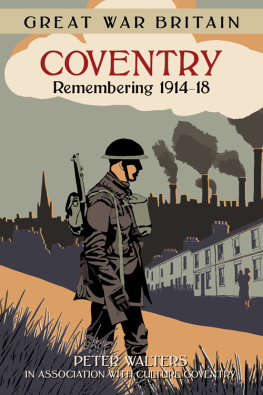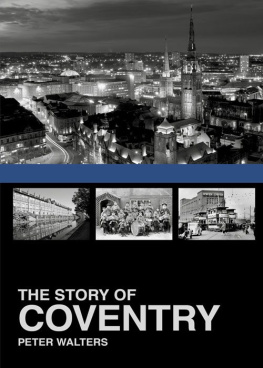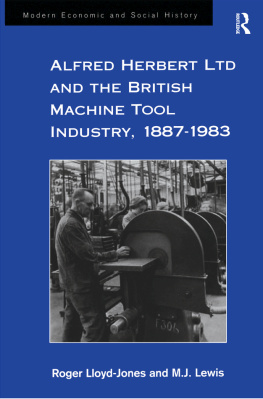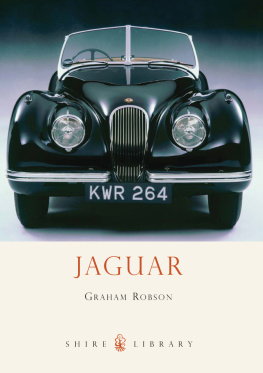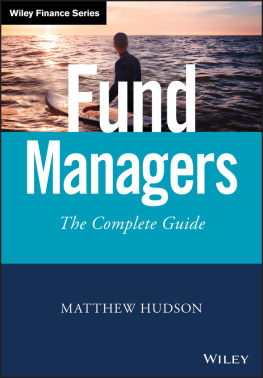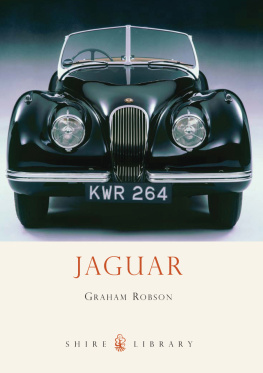The Coventry Motor Industry
The Coventry Motor Industry
Birth To Renaissance?
David Thoms and Tom Donnelly
First published 2000 by Ashgate Publishing
Reissued 2018 by Routledge
2 Park Square, Milton Park, Abingdon, Oxon OX14 4RN
711 Third Avenue, New York, NY 10017, USA
Routledge is an imprint of the Taylor & Francis Group, an informa business
Copyright 2000 David Thoms and Tom Donnelly
The authors have asserted their right under the Copyright, Designs and Patents Act, 1988, to be identified as the authors of this work.
All rights reserved. No part of this book may be reprinted or reproduced or utilised in any form or by any electronic, mechanical, or other means, now known or hereafter invented, including photocopying and recording, or in any information storage or retrieval system, without permission in writing from the publishers.
Notice:
Product or corporate names may be trademarks or registered trademarks, and are used only for identification and explanation without intent to infringe.
Publisher's Note
The publisher has gone to great lengths to ensure the quality of this reprint but points out that some imperfections in the original copies may be apparent.
Disclaimer
The publisher has made every effort to trace copyright holders and welcomes correspondence from those they have been unable to contact.
A Library of Congress record exists under LC control number: 99053974
ISBN 13: 978-1-138-73926-0 (hbk)
ISBN 13: 978-1-315-18419-7 (ebk)
Coventry is synonymous with both the creation and relative decline of the British motor car industry. Our purpose in writing this volume is to explore the relationship between the car industry in this specific local context and the wider economic, social and political environment. The book analyses the emergence and early dominance of Coventry's motor manufacturers, the rise of volume production in the 1930s and the instabilities of the post-war era. Specific chapters deal with the industry's response to the demands created by the two world wars. A number of themes run throughout the book including the structure of the industry and the relationship between its various sectors, resource provision, management and labour relations, and the nature of and response to market demand. The book represents a substantially revised version of The Motor Car Industry in Coventry Since the 1890s which was published by Croom Helm in 1985. Use has been made of primary and secondary material which has become available since the original volume appeared, while the analysis has been extended to incorporate recent developments in the history of Coventry's motor vehicle industry.
We remain grateful to colleagues in our respective universities, in the various record offices and motor-vehicle companies who have assisted our research in a variety of ways, and to our friends and families for their support. Particular thanks are due to Ann Holton, Muriel Morgan and Sheila Petticrew for wrestling with our vain attempts at word processing and turning this into a meaningful document. Publication of this volume was assisted by a grant from the Peugeot Heritage Trust.
Chapter 1
The Coventry Motor-Car Industry: Parameters and Significance
The foundations of British motor-vehicle production were laid in Coventry in the 1890s as the city moved away from its traditional industries of textiles and watchmaking towards the manufacture of cars and their components. Daimler, Rover, Standard, Siddeley and Riley are among the famous marques associated with Coventry from its early car-making days and, although competition soon arrived from other parts of the country, for a short time the city represented in essence the British motor industry. Coventry's rapid industrial expansion in the late nineteenth and early twentieth centuries was also associated with electrical and aeronautical engineering, machine tools and artificial fibres, producing a cluster of enterprises based on relatively high levels of science and technology.
The reasons for Coventry's chequered experience during this period centre upon the replacement of the ailing crafts of silk weaving and watchmaking as the principal sources of income and employment by the new engineering products of cycles, motor vehicles and machine tools. By 1911 the vehicle and metal industries together absorbed just over 41 per cent of Coventry's occupied population, while watchmaking and silk weaving, which for most of the nineteenth century had dominated the labour market, accounted for less than 6 per cent of the total. These changes were accompanied by a rise in the scale and complexity of production. Although factory organisation was found in textiles and watchmaking, both industries relied heavily upon relatively small-scale enterprises. Many of the early cycle firms were also modest in their resources and output, but with the expansion of demand and greater capitalisation the industry became dominated by a number of very large firms such as Rudge Whitworth whose 2,700 employees in 1906 were responsible for the manufacture of 75,000 cycles. By 1914 volume production had modified traditional work patterns, though in most areas, including motor vehicles, the specialised skills of the craftsman had not yet been superseded by the more routine activities of the assembly-line worker.
The social impact of Coventry's relatively late industrial revolution further illustrates the exceptional speed and magnitude of change. After a reversal in the 1860s, the earlier pattern of steady population growth reasserted itself. In 1901 the city's inhabitants numbered 69,978 but by 1911 the largest recorded decennial increase of 52 per cent had taken the total to 106,349. During the 1890s, inward migration became a significant factor in Coventry's demographic experience, but between 1901 and 1911 it emerged as the One of the consequences of this phenomenon was that it helped to produce a relatively young population, which no doubt influenced other social trends, such as marriage and birth rates, both of which were above the national average in 1911.
The peak year of the cycle boom in 1896 brought a flood of immigrants to Coventry and an immediate housing crisis. According to the city's Medical Officer of Health, 'Houses could not be built fast enough to accommodate the inrush.' Yet, with the industrial expansion and population growth of the war years and beyond, inadequate supply remained a continuing feature of Coventry's housing market.
Similar difficulties plagued education as the schools bulged under the impact of a rapidly expanding child population. When the Local Education Authority assumed its responsibilities in 1903 it was already disadvantaged by the laxity of its predecessor, the Coventry School Board, which had been slow to respond to the new pressures, but the problem was compounded by the development of the peripheral areas where school building had not been designed to cope with the heavy demand which appeared after the turn of the century.
Although the local authority was slow to respond to Coventry's housing shortage, important steps were taken to ameliorate other concerns in the decade before the First World War. Environmental health was gradually improved and by 1910 this was said to have contributed significantly to the city's declining death rate. Maternal and infant health care received particular attention, with the appointment in 1901 of a woman health visitor and in 1905 the introduction of a limited scheme of school medical inspection. Under pressure from the local branch of the Women's Co-operative Guild, Coventry was one of the first cities in Britain to establish an infant welfare clinic in 1915.


